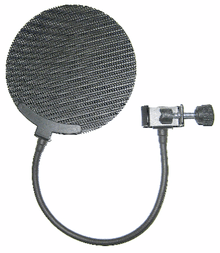Pop filter


A pop filter, pop shield or pop screen is a noise protection filter for microphones, typically used in a recording studio. It serves to reduce or eliminate popping sounds caused by the mechanical impact of fast-moving air on the microphone during recorded speech and singing. Additionally, a pop filter can protect against the accumulation of saliva on the microphone element. Salts in human saliva are corrosive; therefore, use of a pop filter may improve the lifespan of the microphone.[1]
Construction
A typical pop filter is composed of one or more layers of acoustically semi-transparent material such as woven nylon stretched over a circular frame, and often includes a clamp and a flexible mounting bracket. Metal pop filters use a fine mesh metal screen in place of the nylon. Some studio condenser microphones have an integral pop filter built into their design.
An improvised pop shield, functionally identical to the professional units, can be made with material from tights or stockings stretched over a kitchen sieve, embroidery hoop or a loop of wire such as a bent clothes hanger. It is important that the pop shield not be attached directly to the microphone as vibrations will be transmitted from the shield to the mic.
Function
Popping sounds occur particularly in the pronunciation of aspirated plosives (such as the first 'p' in the English word "popping"). Pop filters are designed to attenuate the energy of the plosive, which otherwise might exceed the design input capacity of the microphone, leading to clipping. In effect, the plosive's discrete envelope of sound energy is intercepted and broken up by the strands of the filter material before it can impinge on, and momentarily distort, the sensitive diaphragm of the microphone. Pop filters do not appreciably affect hissing sounds or sibilance, for which de-essing is used.
A pop filter differs from a microphone windscreen. Pop filters are generally used in a studio environment, while windscreens are typically used outdoors. Windscreens are also used by vocalists on stage to reduce plosives and saliva, though they may not be as acoustically transparent as a studio pop filter.
See also
References
- ↑ Russell, Mike. "The Microphone Pop Shield". Retrieved November 17, 2012.
External links
| Wikimedia Commons has media related to Professional audio recording. |